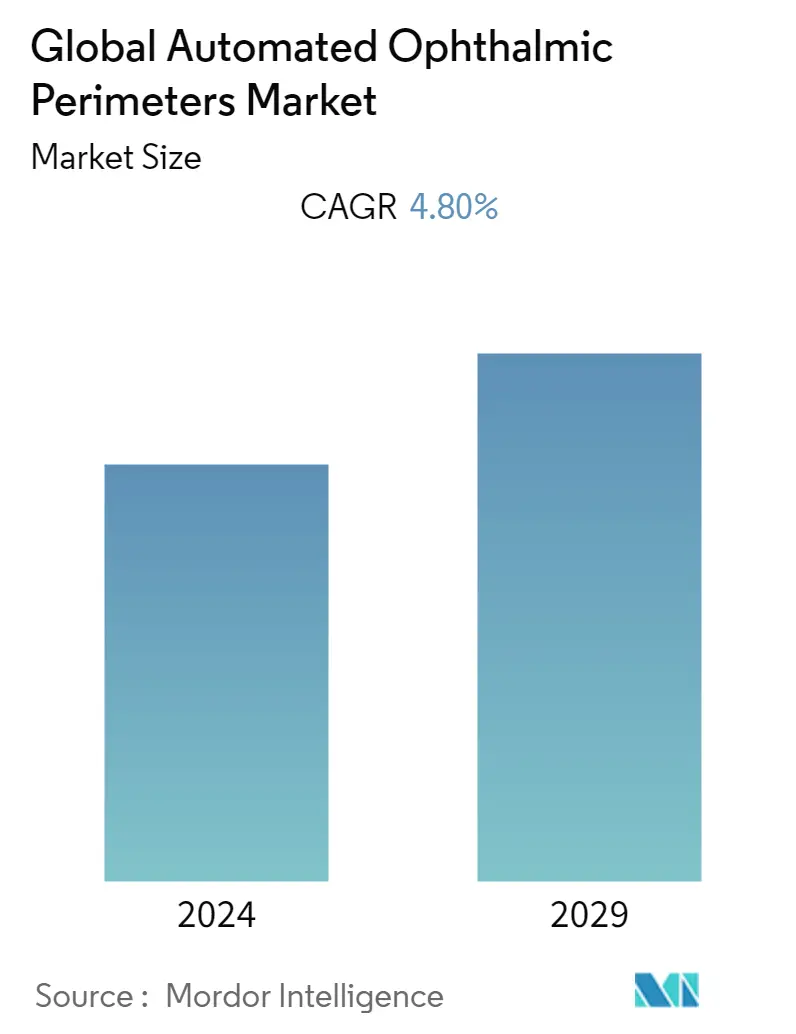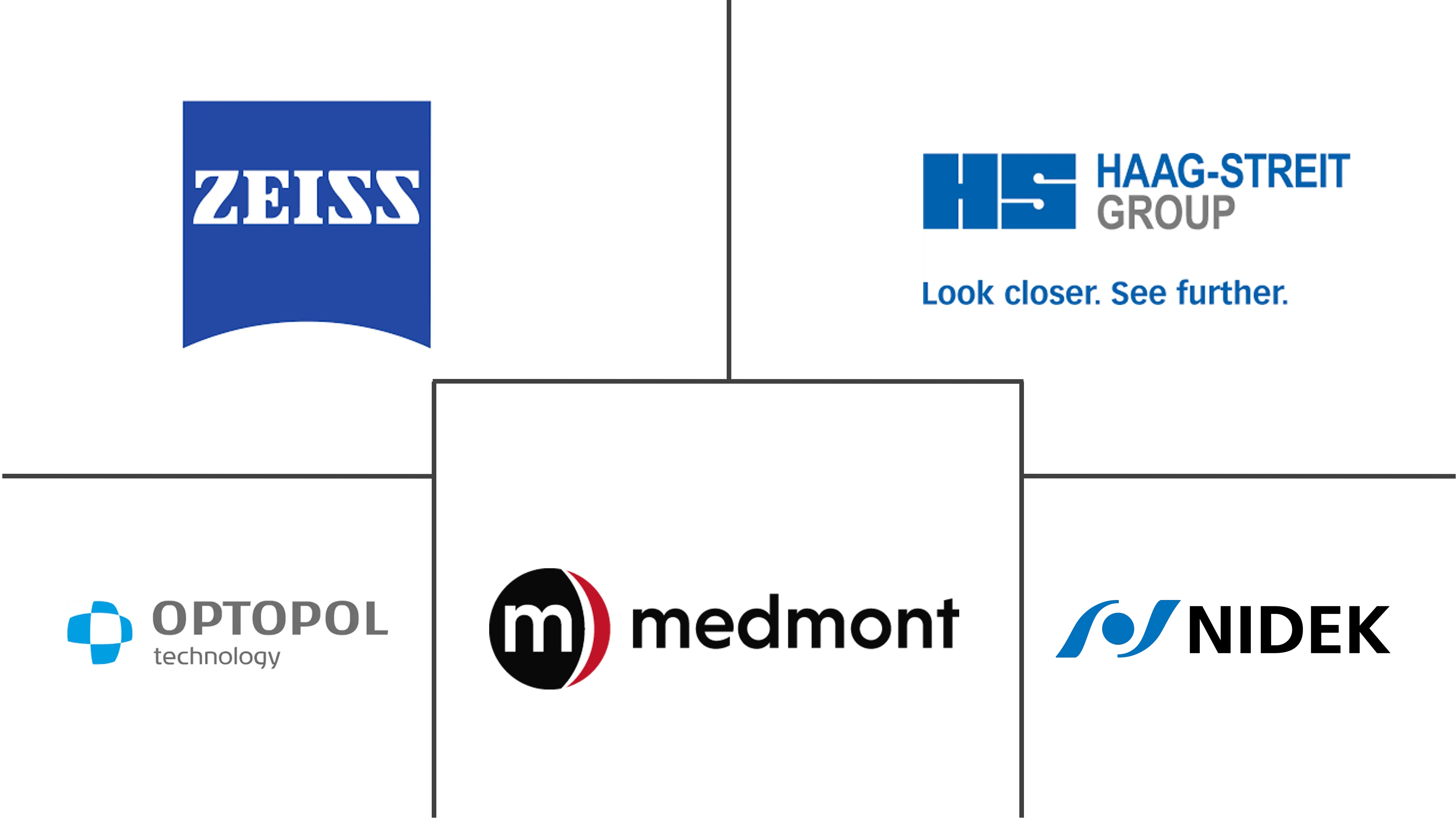Market Size of Global Automated Ophthalmic Perimeters Industry

| Study Period | 2019 - 2029 |
| Base Year For Estimation | 2023 |
| CAGR | 4.80 % |
| Fastest Growing Market | Asia-Pacific |
| Largest Market | North America |
| Market Concentration | Medium |
Major Players
*Disclaimer: Major Players sorted in no particular order |
Automated Ophthalmic Perimeters Market Analysis
The Automated Ophthalmic Perimeters Market studied is expected to grow with an estimated CAGR of 4.8%, over the forecast period.
COVID-19 related restrictions such as lockdown and restrictions on manufacturing activities have negatively impacted the market for automated ophthalmic perimeters. However, deteriorating vision quality due to prolonged mask use and a rising number of ophthalmic complications related to the pandemic are anticipated to boost the growth of the Automated Ophthalmic Perimeters Market. According to an article published by PubMed in 2021, the inappropriate wearing of face masks can cause visual field artifacts, which may be interpreted as low-test reliability or glaucoma progression.
The visual field can be impaired due to diverse diseases mostly by oculars such as retinitis pigmentosa, glaucoma, neurological disorders, and diabetic retinopathy. Ophthalmic perimeters are used in the diagnosis and detection of age-related macular degeneration, glaucoma, brain abnormalities, and scotomas. Automated perimetry offers several advantages over manual perimetry in that recording of patient responses as well as stimulus presentation can be standardized, leading to more reproducible results. Also, it delivers more sensitive and accurate findings in a timely manner, offers quantitative information, and early detection of glaucomatous damage is possible due to newer perimetric tests. This has increased the demand for automated ophthalmic perimeters in the industry.
The high prevalence of ophthalmic diseases is anticipated to drive the Automated Ophthalmic Perimeters Market over the forecast period. According to the World Health Organization in 2021, approximately 2.2 billion people have a near or distance vision impairment globally in 2020. Also, according to the World Health Organization estimation in 2021, approximately 76 and 195.6 million people were affected by glaucoma and age-related macular degeneration respectively in 2020.
Furthermore, the growing geriatric population is anticipated to propel the market over the forecast period. According to the World Population Ageing 2019 report published by United Nations, about 703 million people were aged 65 years or over in 2019 and projected to double (1.5 billion) by 2050. However, the scarcity of ophthalmologists, the high cost of automated ophthalmic perimeters, and increased competition and price pressure among major device manufacturers are likely to restrain the market growth over the forecast period.
Automated Ophthalmic Perimeters Industry Segmentation
Automated ophthalmic perimeters offer systematic measurement of the visual field and are an essential component of defining the extent and progression of glaucoma, as well as numerous other eye conditions. All automated ophthalmic perimeters measure sensitivity to certain stimuli at multiple locations in the visual field, though multiple variables define the perimeter. The Automated Ophthalmic Perimeters Market is segmented by Product (Static and Kinetic), End-user (Hospitals, Ophthalmic Clinics, and Others), and Geography (North America, Europe, Asia-Pacific, Middle East, and Africa, and South America). The market report also covers the estimated market sizes and trends for 17 different countries across major regions, globally. The report offers the value (in USD million) for the above segments.
| By Product | |
| Static | |
| Kinetic |
| By End User | |
| Hospital | |
| Ophthalmic Clinics | |
| Others |
| Geography | |
| North America | |
| Europe | |
| Asia-Pacific | |
| Middle East and Africa | |
| South America |
Global Automated Ophthalmic Perimeters Market Size Summary
The Automated Ophthalmic Perimeters Market is poised for growth, driven by the increasing prevalence of ophthalmic diseases and the rising geriatric population. Automated perimetry offers significant advantages over manual methods, such as standardized patient response recording and more sensitive, accurate findings, which enhance early detection of conditions like glaucoma and age-related macular degeneration. Despite challenges posed by the COVID-19 pandemic, including manufacturing disruptions, the market is expected to benefit from the growing need for vision assessment due to complications arising from prolonged mask use. However, factors such as the scarcity of ophthalmologists, high costs, and competitive pricing pressures may hinder market expansion.
North America is anticipated to maintain a dominant position in the market, supported by a substantial geriatric population and a high prevalence of ophthalmic disorders. The region's rapid adoption of new technologies, increased awareness, and significant healthcare expenditure are expected to further bolster its market share. The market is moderately competitive, with key players like ZEISS International, HAAG-STREIT GROUP, and NIDEK CO., LTD. holding significant shares. Technological advancements, particularly in static automated ophthalmic perimeters, are driving the market forward, with innovations in software algorithms enhancing testing accuracy and efficiency.
Global Automated Ophthalmic Perimeters Market Size - Table of Contents
-
1. MARKET DYNAMICS
-
1.1 Market Overview
-
1.2 Market Drivers
-
1.2.1 Rise in the Prevalence of Ocular Disorders and Increase in Geriatric Population
-
1.2.2 Technological Advancement
-
-
1.3 Market Restraints
-
1.3.1 High Cost of Products
-
-
1.4 Porter's Five Force Analysis
-
1.4.1 Threat of New Entrants
-
1.4.2 Bargaining Power of Buyers/Consumers
-
1.4.3 Bargaining Power of Suppliers
-
1.4.4 Threat of Substitute Products
-
1.4.5 Intensity of Competitive Rivalry
-
-
-
2. MARKET SEGMENTATION
-
2.1 By Product
-
2.1.1 Static
-
2.1.2 Kinetic
-
-
2.2 By End User
-
2.2.1 Hospital
-
2.2.2 Ophthalmic Clinics
-
2.2.3 Others
-
-
2.3 Geography
-
2.3.1 North America
-
2.3.2 Europe
-
2.3.3 Asia-Pacific
-
2.3.4 Middle East and Africa
-
2.3.5 South America
-
-
Global Automated Ophthalmic Perimeters Market Size FAQs
What is the current Global Automated Ophthalmic Perimeters Market size?
The Global Automated Ophthalmic Perimeters Market is projected to register a CAGR of 4.80% during the forecast period (2024-2029)
Who are the key players in Global Automated Ophthalmic Perimeters Market?
ZEISS International , HAAG-STREIT GROUP , Medmont , OPTOPOL Technology Sp. z o.o. and NIDEK CO., LTD. are the major companies operating in the Global Automated Ophthalmic Perimeters Market.

